Are you searching for an 1891 Indian head penny value guide to know if the shiny penny in your hand is worth a small fortune? Or perhaps you’re just curious and simply want to learn a thing or two about this coin. Either way, you’ve come to the right place.
| 1891 Indian Penny Value Table | ||
| Grading | No mint mark (P) | Proof |
| Good (G) | $5 | – |
| Very good (VG) | $6 | – |
| Fine (F) | $8 | – |
| Very fine (VF) | $15 | – |
| Extremely fine (XF) | $30 | – |
| About uncirculated (AU) | $44 | – |
| Uncirculated (MS60) | $70 | – |
| MS/PR 61 | $85 | $200 |
| MS/PR 62 | $100 | $300 |
| MS/PR 63 | $210 | $350 |
| MS/PR 64 | $325 | $450 |
| MS/PR 65 | $900 | $675 |
| MS/PR 66 | $1,350 | $2,250 |
Features of the 1891 Indian head penny
In the late 19th century, coinage in America was a canvas for intricate artworks, a reflection of the nation’s consciousness, and an embodiment of its history. The 1891 Indian Head Penny stands as a testament to this era of rich narrative depicted through minting.
Obverse of the 1891 Indian head penny
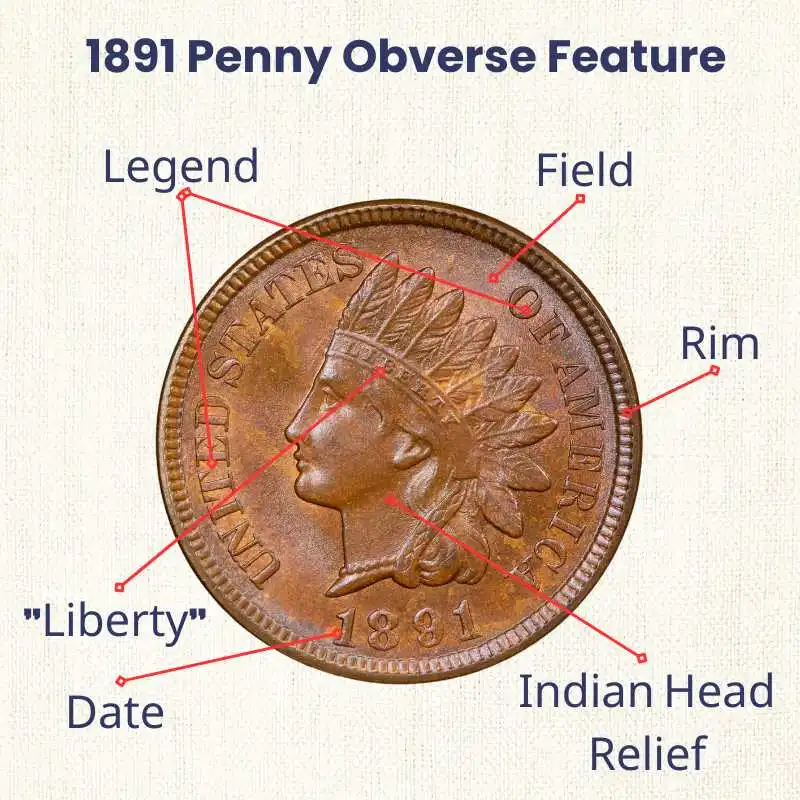
The obverse design of the coin was created by James Longacre and was featured on one cent coins from 1856 to 1909.
The 1891 penny had the following elements
- Left-facing image of Lady Liberty wearing a Native American feathered headdress with “LIBERTY” written on it.
- The broken legend “UNITED STATES OF AMERICA” with the phrase “UNITED STATES” on the left, and “OF AMERICA” on the right.
- The release year, “1891,” was engraved and arching along the lower rim.
Some numismatic experts hold that the image on the coin isn’t liberty, but actually Sarah, the daughter of James Longacre who designed the Indian pennies. But unsurprisingly, these claims were denied by Longacre and his daughter.
Reverse of the 1891 Indian Head Penny

As I’m sure you expected, Longacre also designed the reverse of the coin and included the following elements
- The face value “ONE CENT” in the center
- Wreath of oaks circling the face value
- Presidential badge at the top of the coin
Other Features of the 1891 Indian Head Penny
Other features of the coin that aren’t immediately obvious are its weight, diameter and composition. It has a weight of 0.11 Oz (3.11 g), a diameter of 0.748 In (19 mm) and a composition of 95% copper and 5% zinc and tin, making it a bronze penny.
Interestingly, if you were to melt down this penny, it would still be worth more than its face value. With this size, weight, and composition, the coin has a melt value of about $0.025. But these coins are worth much more; you should never sell them by melt value.
| 1891 Indian Head Penny Features | |
| Face value | One cent ($0.01) |
| Composition | 95% copper and 5% zinc and tin |
| Mint mark | No mint mark (Philadelphia mint) |
| Shape | Round |
| Diameter | 0 748 In (19 mm) |
| Weight | 0.11 Oz (3.11 g) |
| Edge | Smooth |
| Mintage | Approximately 47,070,000 and 2,350 proofs |
Value Guide For 1891 Indian Head One-Cent Coin
There were approximately 47 million of these coins released in 1891. The moderately high number and the fact that they were one of the later releases of the Indian head series makes the coins fairly common. Moreover, this lack of rarity, in turn, makes them less valued than older and rarer coins.
No mint mark 1891 Indian Head Penny Value
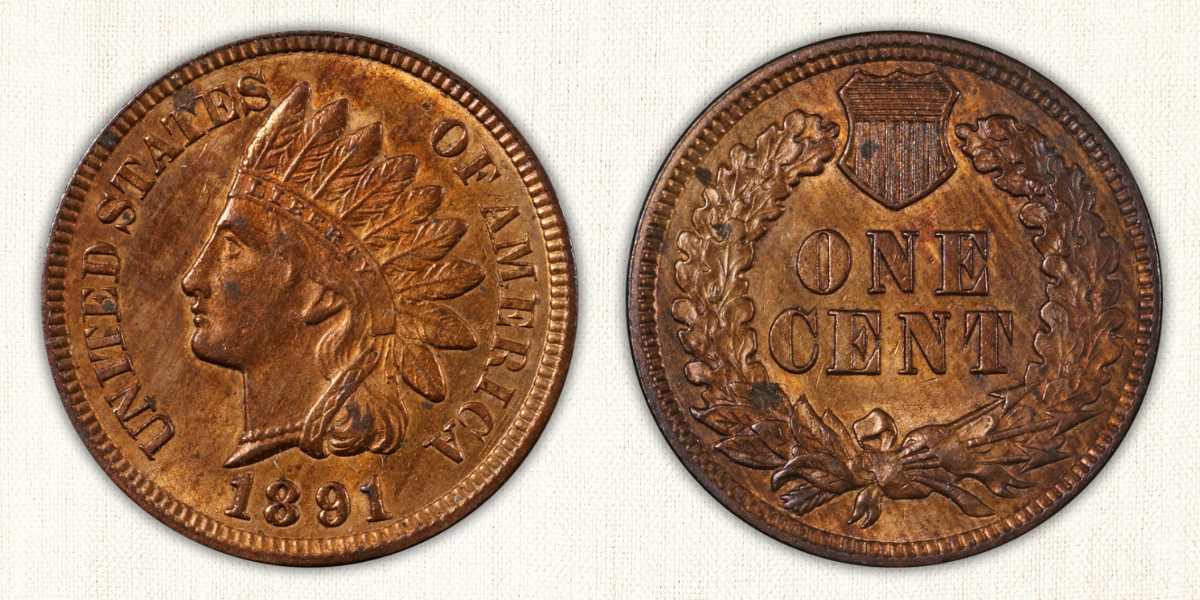
You probably haven’t noticed, but this coin does not have a mint Mark. The reason for this is that all 47 million of these coins were made by the Philadelphia Mint, which at that time did not use mint marks for its coins.
Consequently, mint marks don’t have any effect on the value of this coin. What determines the value is the color and condition of the coin. Thus, the values can range from as little as $4 for the lowest quality to as much as $23,000 for the highest.
Brown (BN)
Brown coins have the lowest value, starting at $4 and topping out at $700 for an MS66 grade.
This price shows a $40 increase in value over the auction record of $660 for an MS66 coin auctioned by Heritage Auctions in December 2022.
Red and Brown (RB)
Red and brown coins are next in the value chain. The lowest available grade for this coin is MS60, for which you’ll pay $75. The highest value is an MS66 at $1,350.
Red (RD)
Red 1891 Indian cents are top-tier, and you’d be hard-pressed to find any in less than mint state. MS60 grades of this coin are valued at $100 while MS66 goes for $5,000, and a true “red gem” with a grade of MS66+ (not quite MS67) doubles that value to $10,000.
The prices of the higher grades show that the coin is in considerable demand from numismatists. More proof of this is an April 2009 auction held by Heritage Auctions that saw a red 1891 Indian head penny graded MS66 sell for an impressive $14,950.
1891 Indian Head Coin Proof Value

Proof coins of the 1891 Indian head penny have much higher values than the general circulation coins. The value of 1891 Indian head penny proofs ranges from $150 to $23,000
Brown (BN)
Brown proofs start at grade PR60, valued at $150. A PR65 and PR65+ cost $675 and $875 respectively. But the highest of all is the PR66 grade, valued at $2,150.
Red and Brown (RB)
If you prefer a red and brown proof of the 1891 Indian head coin, it will cost you $175 for a PR60 grade, $300 for PR62, and $2,250 for a PR66.
Red (RD)
Red proofs of the 1891 Indian head one-cent go for $250 for a PR60 and as much as $3,000 for a PR66. In between, you can get a PR63+ and PR65+ for $450 and $2,350 respectively.
Cameos (CAM)
After red proofs are the cameos. Cameos have a mirror-like background and a frosted finish. They are rarer than regular proofs and are almost always red. The starting grade of an 1891 Indian head cameo coin is PR63, worth $575. A mid-tier PR64 costs $1,350, and a PR65 sells for $3,000.
Deep Cameos (DCAM)

Deep cameos are the rarest of the bunch. PCGS has certified only one 1891 Indian head penny as DCAM, with a grade of PR 65 and valued at $23,500.
The value of this coin has increased by more than 28% as heritage auctions first auctioned it for a whopping $18,212.50 in July 2014.
| 1891 Indian Head Penny Auction Records | ||
| Coin type and grade | Amount | Auctioneer and Date |
| Uncirculated – BN MS66 | $660 | Heritage Auctions – 12/06/22 |
| Uncirculated – RD MS66 | $14,900 | Heritage Auctions – 30/04/09 |
| Proof – DCAM PR 66 | $18,212.50 | Heritage Auctions – 07/10/14 |
1891 Indian Head Off-Center Strike Error Coins
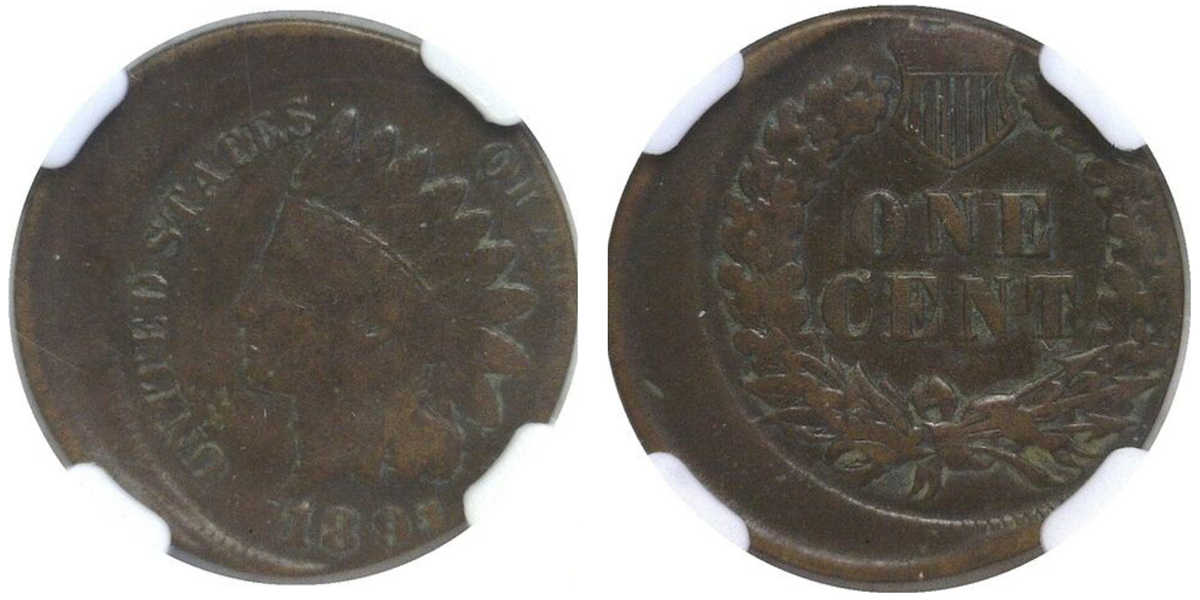
There are a considerable number of 1891 Indian head penny error coins. The most common error coins are those struck off-center.
An off-center error occurs when the planchet (plain metal disk) isn’t positioned properly before the die is struck. As a result, only part of the coin gets engraved, and the other part is left plain.
Error coins typically have a greater value than perfect coins of the same grade, especially with low-grade brown coins.
1891 Indian Head Off-Center Struck 15% Off Center

This 1891 Indian head penny has a 15% off-center error that results in a large blank section on both sides of the coin. As a result, on the obverse side, the last digit of the date does not appear. While on the reverse, some of the oak wreath isn’t shown.
Despite the error, this coin is NGC-graded F-15 BN and is priced at $344.5, far more than non-error coins with similar grades.
1891 Indian Head Penny Struck 5% Off Center
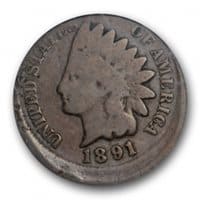
This coin was priced at $240. It has a grading of G4 with a 5% off-center error that presents as a small blank crescent at the bottom of the coin.
1891 Indian Head Penny Struck 10% Off Center
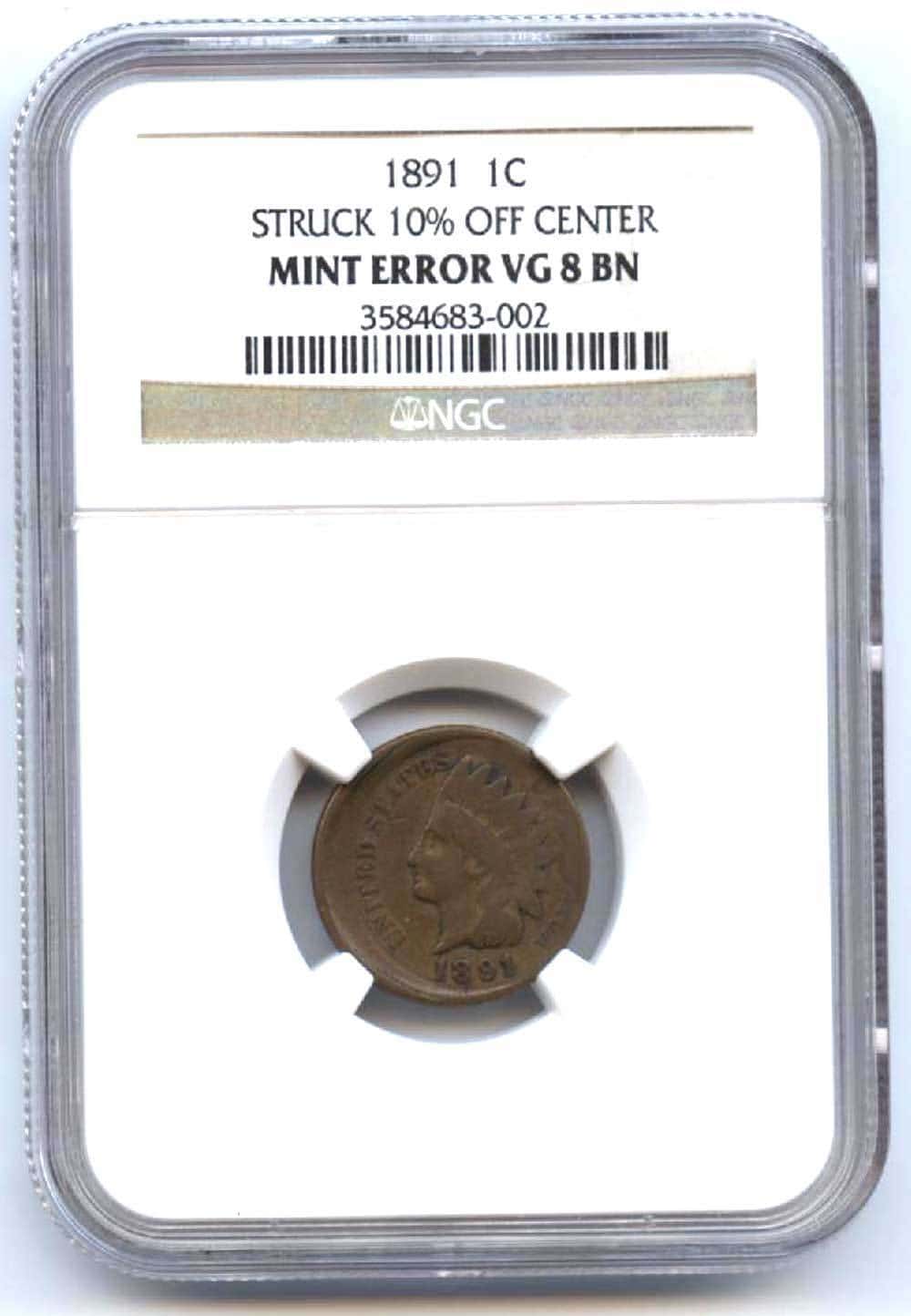
Valued at $2,600, this brown 1891 Indian head penny with a PCGS grade of VG-8 has a 10% off-center error. As a result, the obverse shows a blank section at the left, and the usual “of America” legend does not appear on the penny.
1891 Indian Head Penny Triple Struck, Third Strike 90% Off Center

Third time’s the charm! As you can tell from the name, this coin was struck thrice. The third strike was 90% off-center resulting in an oddly shaped penny, mostly round but with a small protrusion.
The coin is NGC certified with a grading of XF-45 BN and valued at $3,000.
Double Struck Flip Over, Second Strike Off Center

This rare 1891 Indian head one-cent error coin is worth an estimated $729.
It’s a double-struck coin, with the second strike off-center and flipped over. Due to this error, a small section of the reverse design shows up on the right edge of the obverse.
The error likely happened when the coin didn’t fully exit the dies after the first strike but was instead flipped over, with a small portion remaining in the die, giving it a second strike.
Summary
The 1891 Indian head penny has a mintage of 47 million making it somewhat common and not as valuable as some of the rarer or special coins. The prices range from $5 for the lowest grade to $23,000 for the highest proof grades.
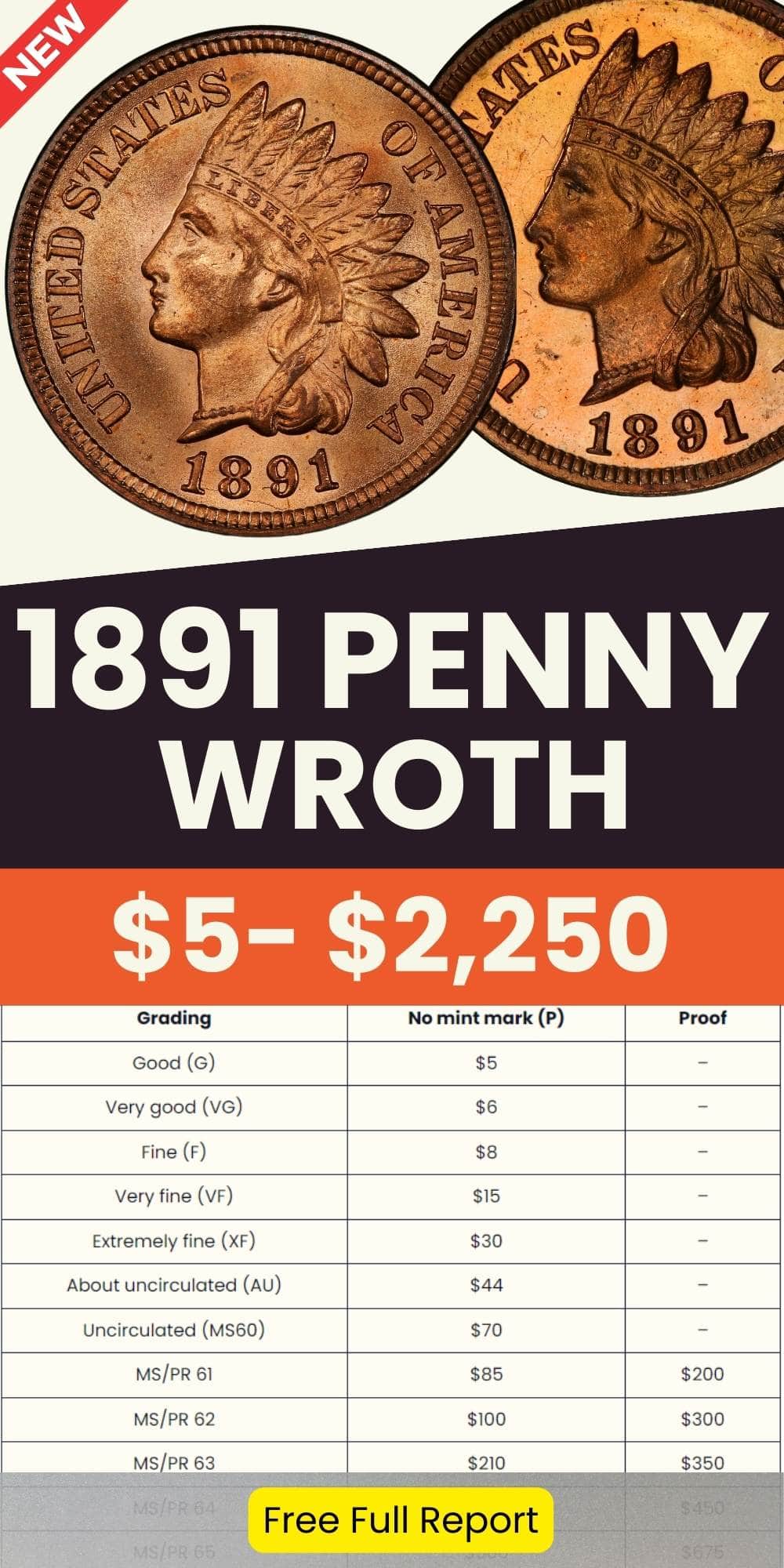
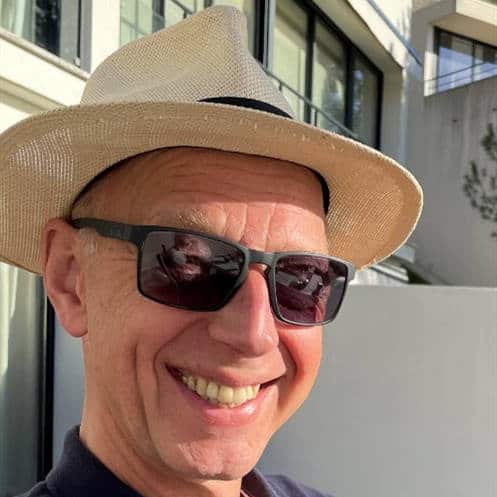
Jenson is a professional numismatist, a dedicated coin collector, a graduate of the College of Business at Oregon State, a life member of the American Numismatic Association (ANA), and an overall coin nerd. He is the founder of Coin Value List.
